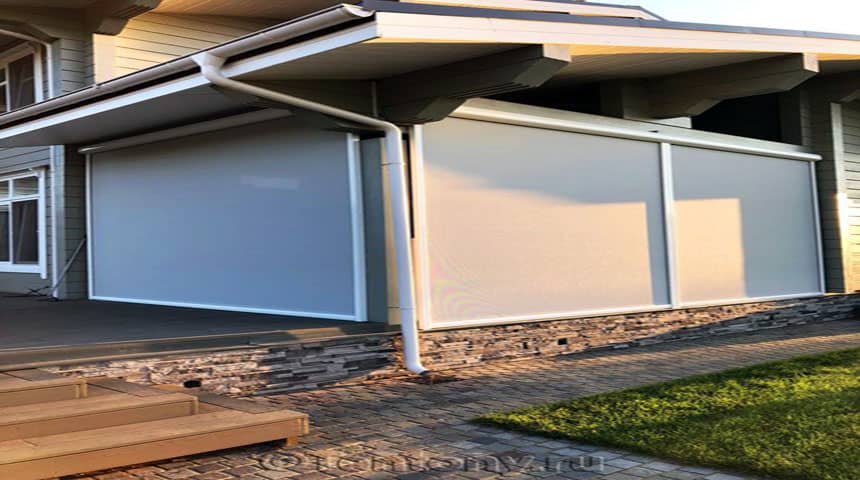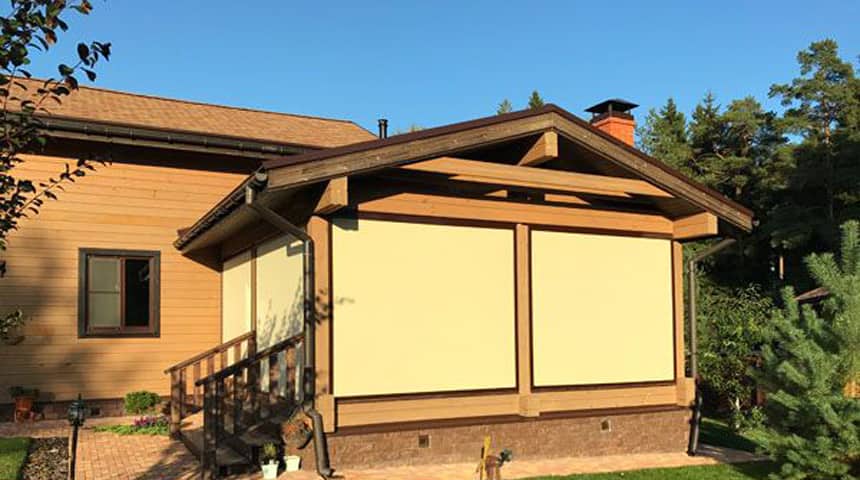The outdoor vertical awning is primarily a sun protection for the terrace and garden. The awning, also known as a solar blind, is available in manual or electric form and is an indispensable source of shade. In this guide you will learn how to choose the right dimensions and material and whether you should opt for a semi-open or cassette awning or a remote-controlled model.
The advantages of the outdoor vertical awning.
Providing reliable protection against solar radiation and playing an important role in thermoregulation, outdoor vertical awnings are essential for enjoying the terrace even during the hottest hours of the day, or simply for spending time in the coolest shade.
In a way, an outdoor vertical awning increases the indoor living space and prevents the interior from heating up through windows and doors, which are no longer exposed to direct sunlight. There are many types of awnings that combine utility and aesthetics and, depending on the model, can also serve as rain protection.
There are models of electrically extendable and retractable vertical outdoor roller awnings, large or small additional elements, and it is no exaggeration to say that there is an awning for every living configuration and every region.
The dimensions of outdoor vertical awnings.
As mentioned above, the main function of an external vertical awning is to protect (as a kind of shield) from the sun. For this protection to be effective, the outdoor vertical awning must be chosen with the right dimensions. These depend on the area to be protected.
The measuring principle seems simple: the vertical outdoor awning should be larger than the area to be covered and protect from the sun over a large area, especially over openings (windows and doors). Awnings are available in standard sizes from three metres wide.
However, it is a bit more complicated, because our planet is moving and the angle of the sun’s rays is changing accordingly. It is therefore important to consider the direction and angle of exposure to the sun and shade in advance, depending on the area to be protected.
On the internet you can find programs to simulate solar radiation and the corresponding formation of shadows. Take a look, these programs are not complicated!
In addition, the maximum extension of the articulated or drop arm must be determined. In general, this is between 1.50 and 4 metres. However, most models can be extended up to 3.5 m, although there is a large selection.
The calculation of the required dimensions.
- At what height is the awning placed?
- What is the maximum width for the attachment (including the box)?
- What is the distance between the openings of the house and the roof?
- How large is the area to be covered?
- How large is the area to be covered?
- How high are the lintels?
The different materials of vertical outdoor awnings.
After determining the dimensions, the material is another key element. The quality, but also the properties, determine how resistant the vertical awning is to UV rays and how well it keeps the heat in. There are three different types of fabric.
Polyester fabric for outdoor vertical awnings.
A polyester fabric is sensitive to UV rays and is therefore not particularly durable in the long term. Polyester is an option if you are looking for an economical solution for occasional use. If you take good care of and protect your outdoor vertical awning, you can extend its lifespan.
Acrylic fabric for outdoor vertical awnings.
Acrylic fabric is very insensitive to UV radiation and can be easily cleaned with water. These outdoor vertical awnings are considered weather resistant, perfect for outdoor use and very tear resistant, which gives them a longer life span. A disadvantage is the air tightness.
Micro-perforated awning fabric.
Outdoor vertical awnings with micro-perforation are number 1: they are UV-resistant, tear-resistant, easy to clean with water and also weatherproof. Their advantage: air permeability! Why? Thanks to the micro-perforation, no heat builds up under the awning.
Cleaning the external vertical awning.
When it comes to maintaining your outdoor vertical awning, the most important thing is to regularly remove any dust that has settled on the awning so that the fabric does not fade over time. It is also advisable to wash the cloth with soapy water or bleach once or twice a year.

The advantages of an exterior vertical awning.
There is a transparent exterior vertical awning that has a draped valance, an often ornate piece of fabric that hangs at the end of the awning. The most popular are the wave-shaped valances, but there are also straight valances.
However, this is not only a decorative element, but also a complement to protect against the sun’s rays.
The valance can also be deployed to protect against glare when the sun is particularly low, or as a privacy screen when neighbours are particularly curious!
The characteristics of semi-open and cassette external awnings.
This is mainly a question of budget, but not only. You can find an overview of the criteria here.
Half-open exterior vertical awning.
With the half-open awning only the fabric is protected. The hinged arms are folded under the box.
External vertical cassette awning.
The folding arms of the cassette awning are also protected. As a result, the entire structure is protected from the weather. Depending on where and how often you use the external vertical awning, this can be a decisive criterion. In addition, the cassette conceals the entire mechanism and the screw connection. A simple principle: the less you see, the more you protect!
The choice between electric and manual external vertical awning.
Manual awning.
A manual external vertical awning is undoubtedly the most economical option, but you should pay attention to the dimensions of the awning. The larger the awning, the more difficult it is to operate the crank!
An awning is there to provide more comfort. Therefore, the manual option is only interesting for its price and for small awnings.
Electric awning.
An outdoor vertical awning that is extended by means of a wall switch (cable connection) or a remote control (radio) is the ultimate in convenience! Compared to the crank handle, it is an excellent alternative, so you don’t have to do without an additional crank handle – because every technical system can also fail once!
In addition, there are other useful options such as a wind or sun detector so that you don’t have to keep an eye on the weather all the time.
Choosing a motorised system also gives you other options, such as the installation of lighting.
Remember to regularly clean the structure and especially the articulated arms so that the awning can be extended easily and quietly. As always, care means a longer life.
Final tips on the outdoor vertical awning.
Plan the installation of your awning in advance and choose the right fixings. In particular, the anchors must be adapted to the building material of your house and/or terrace.
As a rule, the external vertical awning is attached to the facade of the house. However, it is also possible to mount them on the roof with a special attachment if your roof protrudes slightly (this can also be the most aesthetic option).

